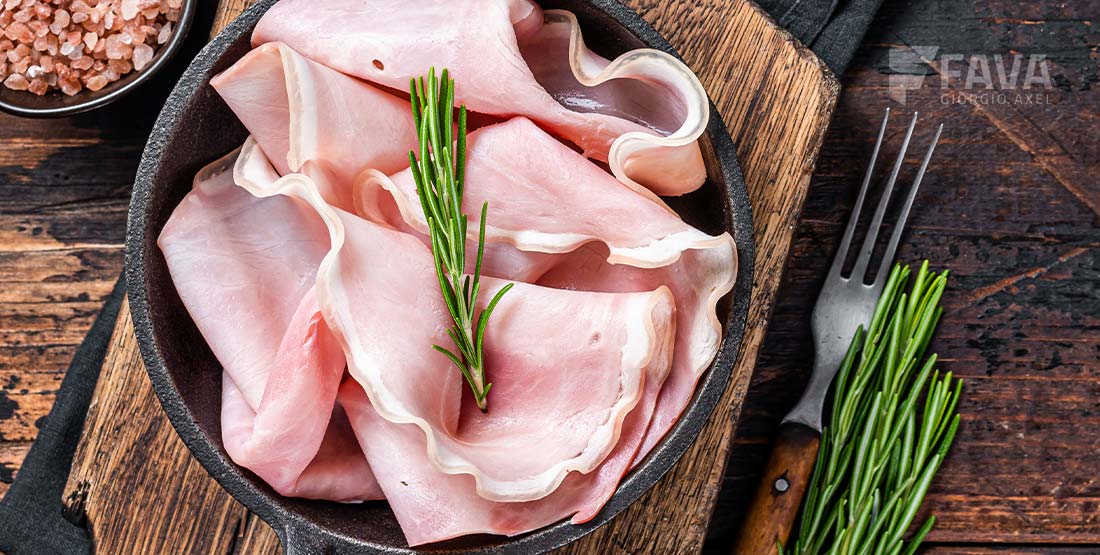Mold
The molding methods influence the seal of the slice, as well as the aesthetic result. The molding has to be careful for high quality products, that is to say with less “adhesive” addition. The molding methods conditions the slice compactness and, of course, the aesthetic result. The molding has to be careful for high quality products, that is to say with less “adhesive” addition. The molding has to be more careful if you want to have the fat in the central part; in fact fat opposes to muscular bands gluing, for this reason it’s important to keep them in contact both during cooking and at its end.
Cooking
Cooking influences the final product organoleptic qualities. It’s better to use a low delta T between fluid and product (about 10°C), it doesn’t matter which cooking method you use (steam or water). In this way the product heating is more homogeneous in the section and you avoid an excessive inhomogeneity of the different muscles contraction. It’s moreover proved that working with a low delta T helps the color enhancement and uniformity. Another variable, that as delta T influences the weight loss and the cooking times, is the cooking maximum temperature which value depends also on the requested pasteurizing effect and on the contaminants you want to destroy.
Another important aspect is the thermic treatment homogeneity, this condition is easier to achieve with water cooking or using piles that facilitate steam flow, but also cooling air flow, in the 3 directions.
Re-pressing
Looking at the most known theories, re-pressing is important when the cooking weight loss is at least 4%. There is a reduction of the muscles volume when there is a weight loss and, when there isn’t an elastic element that keep them, a reduction of the contact pressure between the muscles themselves. When the product is particularly lean and with the right additives, it’s important that the in contact muscular bands do not disconnect to have enough cohesion for slicing with acceptable thickness and productivity. When the product is a high quality one, with fat parts, it’s important to restore the contact pressure between muscles, pressing the molds again. It’s moreover necessary to make a distinction between in bag product and thermoformed product with exudate collecting pockets.
The bag, that protrudes on the molds sides, reduces at the minimum the exudate way and the “blockages” risk, so, normally, it’s not strictly necessary to re-press the molds if the weight loss is small.
The thermoformed product, with pockets on the heads, needs a longer way to collect the exudate and it has more obstruction risks in the pockets connecting channels; this makes re-pressing necessary because the liquid will stagnate at least over the product.
In all the cases a small weight loss and the absence of elastic compensation will cause an irregular distribution over the bar of the exudate, with local sections variations and a worse aesthetic result.
In any case the slicing yields are better when the product is more compact.
Cooling
Another important aspect, above all with big section products, is to make a fast cooling. A fast cooling influences yields and shelf-life (that increases) quality in slicing. When water cooking is used, the cooling is made first with well water, when the delta T is high, then with ice water (1-2°C), properly recirculated, in a way to compensate for the final phase low delta T (about 5°C) with a better exchange coefficient. It will be easy to have a homogeneous cooling of the treated pile. When steam cooking is used, the cooling is made first with shower and then in a ventilated cold room or in a shock freezer. In both cases, but mainly in the first one, it’s important to use piles that facilitate the air flow in all the 3 directions. Water is sprayed in air at -15°C -20°C in the shock freezers, using strong ventilation, in a way to have ice on all the molds surfaces. In this way the latent heat, due to the phase changing, is employed. It’s important to point out that it should be possible a too high local cooling, with very low temperature, but only till the moment the ice is not on the mold ( it has a sort of buffer effect) and anyway it will cause only a surface damage that won’t influence the slicing performances.

